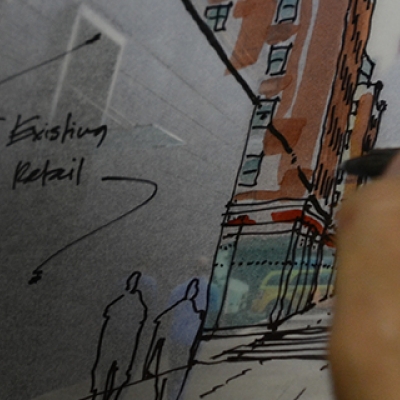


#ForewordFriday: Better Together Edition
By Meghan Bartels / On June 6th, 2014

"Damn Those Congressional Torpedoes, Full Speed Ahead!"
By Hillary Brown / On May 15th, 2014
Last spring's Presidential appeal for fixing the nation’s “raggedy” infrastructure (his word choice) has failed to stir a response from Congress. However, bold moves elsewhere to renew these critical services inspire the title of this post. I’m highlighting the following initiatives because they epitomize the new norms needed to “future-proof” our infrastructure.

ForewordFriday: Welcome to Bo01 Edition
By Jason Leppig / On March 21st, 2014

Making Downtowns Liveable
By Admin / On August 5th, 2013
Harold Henderson of Build a Better Burb interviewed author Ned Crankshaw, author of Creating Vibrant Public Spaces: Streetscape Design in Commercial and Historic Districts. He chairs the Department of Landscape Architecture at the University of Kentucky.

It Is a Matter of Scale or What is the Connection between Brain Size and Sprawl
By Admin / On September 26th, 2011
Scale is fundamental to urban design. If you get it right, and achieve a well-proportioned space between buildings, you have a sound basis to build upon. Even if the architecture is far from perfect, the public realm you create can be decent and comfortable. If you get the scale wrong and your master plan is built, even the most lustrous architecture won’t remediate the failure of space-making; people might still use it for utilitarian reasons (think the parking lot of a Wal-Mart), but will not enjoy it.

Reduced or Not, the Mortgage Interest Deduction Can Help Fix Sprawl
By Galina Tachieva / On September 19th, 2011
As of late, the mortgage interest deduction (MID), a tax break many Americans have become accustomed to, has become the focus of much debate and controversy. It first became the subject of heated discussion when President Obama’s debt commission suggested its reduction. They argued that in addition to reducing deficits, such reform could also help slow the growth of sprawl.

Smithsonian Institution Greening Greater Washington seminar
By Admin / On September 7th, 2011
Island Press partnered with the Smithsonian Institution for a Greening Greater Washington Seminar featuring Island Press author Timothy Beatley, author of Biophilic Cities, and Christopher Leinberger, author of The Option of Urbanism.

Innovations in Urban Green, Questions for Peter Harnik
By Admin / On July 20th, 2010
Peter Harnik discusses ideas from his new book Urban Green: Innovate Parks for Resurgent Cities on the Trust for Public Land's City Parks blog:

Peter Newman's Resilient Cities: The Sustainable Transport City
By Peter Newman / On March 12th, 2009
Cities, neighborhoods and regions will be designed to use energy sparingly by offering walkable, transit-oriented options for all supplemented by renewably-powered electric plug-in vehicles. Cities with more sustainable transport systems have reduced ecological footprint from their reduced fossil fuels and greater chance of enhancing their ecology through reduced urban sprawl and car-based infrastructure.

